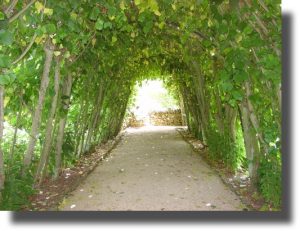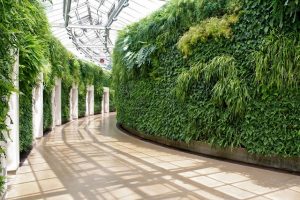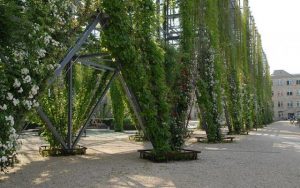For many of us, live plant walls are not new, we have seen them in modern offices as well as in public buildings. More and more people decorate the walls of their apartments or houses with live plant pictures, even larger areas of walls or partitions of vertically grown greening plants are installed. Admiring the new phenomenon, the question when and how the history of green walls started arises… Let’s try to trace back… going back to Babylon.
A live or live plant wall is a vertical plant arrangement on an existing or specially designed wall to keep the beauty of plants in the space for a long time. The plants in these walls are alive, they grow, and smart technology takes care of the huge amount of plants. Vertical walls accommodate many plants in one place, and they naturally remove toxic substances and other pollutants from the air we breathe. It can be a complete ecosystem or simple plant pictures created in urban houses and offices, in order to reduce the impact of pollution on a human being created by civilisation. We should also remember that live plant walls or pictures are also a valuable accent of the interior.
Why plants? By nature, plants serve the earth. They were important to people at all times: they provided food, clothing and shelter. Now more than half of the world’s population lives in industrial cities dominated by concrete structures, glass and metal. However, the world is returning to a green and healthier environment, and designers, architects and planners use plants as a way to fundamentally change the aesthetics of modern infrastructure. In addition, it has been shown that an ecological, green environment provides cleaner air and water, improves the overall environment, human health and mental well-being.

Is the history repeating? Vertical gardens are not new. In fact, they are an ancient concept, and examples from architectural history can be found even in Babylon. The famous Hanging Gardens of Babylon are one of the Seven Wonders of the Ancient World. The Romans also cultivated grapes in a special way, and created their walls, covering the garden sheds or the walls of the luxurious villas. Roses climbing up to the top was the symbol of secret romantic gardens.

View of a city of Great Britain
In the 20th century, with the growth of urban centres, around 1920, in the towns of the Great Britain and United States of America movements encouraging the integration of green gardens or their elements into the urban environment, using climbing plants, supported by various grids and lightweight structures has started. This has resulted in the ever-increasing tendency of urban architecture and environmental design to return live plants to people’s lives, by creating different solutions, but always emphasising the value of a natural live plant. In 1988 stainless steel wire rope was started to be used to turn the house facades into green gardens.

Universal City Walk in California
The Green Wall Street created in California, in 1993, has revealed the value that can be created by innovative engineering solutions for the human environment that enable plants to be presented in a new way, all plants grow horizontally in the green wall and create an impression of intense greenery.

Zurich, Switzerland
In 1994, for the first time in Toronto, Canada, a live plant wall was built inside the building, with a bio-filtration system installed. A particularly impressive wall of live plants was created in Switzerland, Zurich, in 2002, in which 1,300 plants were used.

Japan, Bio-Lung
Japanese people like no other nation know and appreciate plants in densely populated industrial centres. In 2005, the Japanese federal government allocated funds to a huge green wall called Bio-Lung. The wall consists of 30 different module systems.
Live walls are becoming more and more popular today, not only in public buildings, offices, but also in people’s homes, where we strive for a unique style that would be a characteristic of us, not forgetting the benefits of natural, growing plants for human well-being. If a live wall is too large for your space, you can always choose live plant pictures. Keep in mind that creation of plant pictures is an amazing activity, and plant care, although minimal with modern technology, will give you peaceful, meditation moments.


